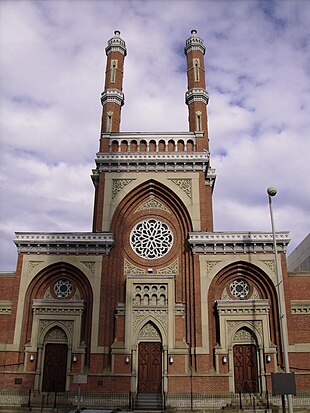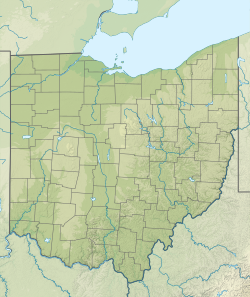| Isaac M. Wise Temple | |
|---|---|
 The Isaac M. Wise Temple, in 2006 | |
| Religion | |
| Affiliation | Reform Judaism |
| Ecclesiastical or organisational status | Synagogue |
| Leadership |
|
| Status | Active |
| Location | |
| Location | Plum Street:
|
| Country | United States |
Location in
Ohio | |
| Geographic coordinates | 39°6′13″N 84°31′5″W / 39.10361°N 84.51806°W (Plum Street) |
| Architecture | |
| Architect(s) | James Keys Wilson |
| Type | Synagogue architecture |
| Style | |
| Date established | 1841 (as a congregation) |
| Completed | 1866 |
| Construction cost | $275,000 |
| Minaret(s) | Two |
| Website | |
|
wisetemple | |
Plum Street Temple | |
 Early 20th century photo of the Plum Street Temple | |
| Area | less than one acre |
| NRHP reference No. | 72001021 |
| Significant dates | |
| Added to NRHP | December 27, 1972 |
| Designated NHL | May 15, 1975 |
| [1] [2] | |
The Isaac M. Wise Temple (formerly the Plum Street Temple), commonly called the Wise Temple, is an historic Reform Jewish congregation and synagogue located in Cincinnati, Ohio, in the United States. The congregation's historic Plum Street temple was erected in honour of Rabbi Isaac Mayer Wise, who was among the founders of Reform Judaism in the United States. The temple building was designed by prominent Cincinnati architect James Keys Wilson and its design was inspired by the Alhambra at Granada. [3]
The temple is located at 720 Plum Street in Cincinnati and was built chiefly during the Civil War at a cost of $275,000 by members of the Lodge Street Synagogue. [4] The temple was dedicated on Friday, August 24, 1866, and is among the oldest synagogue buildings in the United States. [5] The temple is across Plum Street from the historic Saint Peter In Chains Cathedral and next to the site of the former St. Paul Episcopal Cathedral, which was demolished in 1937. In 1972, the Plum Street Temple was placed on the National Register of Historic Places, and it was designated a National Historic Landmark in 1975 for its architecture and its role in the Reform movement. [2]
In 1976, the congregation expanded its facilities to include a new synagogue, community center, and school located in Amberley Village.
History
In 1840, a group of German Jewish immigrants in Cincinnati organized as a separate congregation, K.K. B'nai Yeshurun, breaking away from the existing congregation, K. K. Bene Israel. Their first place of worship was in a home on Third Street, between Sycamore and Broadway. In 1841 the congregation purchased and renovated for use as a house of worship a Federal-style, brick, four-story row house on Lodge Street. [6]
The congregation built its first synagogue in 1848 on Lodge Street in the Gothic Revival style. [6] The Lodge Street Synagogue was dedicated on September 22, 1848 in Cincinnati, Ohio. [7]
The congregation voted in 1853 to engage Rabbi Isaac Mayer Wise as its spiritual leader; this congregation built the Plum Street Temple beginning in 1865. Prior to the Civil War, the 200 families of K. K. B'nai Yeshurun (Isaac M. Wise Temple) envisioned a magnificent building to house their growing twenty-year-old congregation that had already gained a national prominence because of their rabbi, Isaac Mayer Wise. With his energy and vision, the congregation and Cincinnati were fast becoming a center of national Jewish life. Plum Street Temple was built chiefly during the Civil War, at a cost of $275,000. [4] Plum Street Temple was dedicated on Friday, August 24, 1866. The original ledger book with all the entries of specific costs entailed in the construction of Plum Street Temple was found in the early 21st century. A commemorative march for piano, called The Progress March, by P. Martens, was published by J. L. Peters. The temple is featured prominently on the cover. [8]
Louis Grossmann succeeded Wise and served as the Temple's rabbi from 1898 to 1922. [9] James G. Heller was rabbi of the Temple from 1920 to 1952. [10]
In 1972 Sally Priesand was ordained in the Plum Street Temple. Priesand was the first female rabbi ordained by a rabbinical seminary in the United States, and the second formally ordained female rabbi in Jewish history, after Regina Jonas of Germany in 1935. [11] [12] [13]
The Plum Street Temple was listed on the National Register of Historic Places in 1972; and designated as a National Historic Landmark in 1975. [2]
In 1976, the congregation opened the Isaac M. Wise Center on Ridge Road in Amberley Village.
Gallery
-
Postcard of St. Paul Episcopal Cathedral (razed 1937) and Plum Street Temple
-
Isaac M. Wise, rabbi of the Plum Street Temple
See also
References
- ^ "National Register Information System". National Register of Historic Places. National Park Service. January 23, 2007.
- ^ a b c "NHL nomination for Plum Street Temple". National Park Service. Retrieved March 20, 2018.
- ^ Kenny, Daniel (1875). "Illustrated Cincinnati". Stevens. p. 106. Retrieved May 19, 2013 – via Google Books.
- ^ a b Kenny, Daniel J. (1895). "Illustrated Guide to Cincinnati and the World's Columbian Exposition". R. Clarke. p. 124. Retrieved May 22, 2013.
- ^ Gordon, Mark W. (1996). "Rediscovering Jewish Infrastructure: Update on United States Nineteenth Century Synagogues". American Jewish History. 84 (1) (2019 update ed.): 11–27.
- ^ a b The History of the K. K. Bene Yeshurun, of Cincinnati, Ohio, from the Date of Its Organization. Bloch Printing Co. 1892. (Picture available. Book has no page numbers).
- ^ "Lodge Street Synagogue". Cincinnati Memory. Archived from the original (image) on March 26, 2009.
- ^ Peters, J. L. "The Progress March" (PDF). Levy Sheet Music. Johns Hopkins University.
- ^ Landman, Isaac, ed. (1941). The Universal Jewish Encyclopedia. Vol. 5. New York, N.Y.: The Universal Jewish Encyclopedia, Inc. pp. 105–106 – via Google Books.
- ^ "Heller". Encyclopedia.com. Retrieved November 5, 2022.
- ^ "America's First Female Rabbi Reflects on Four Decades Since Ordination". ejewishphilanthropy.com. May 8, 2012. Retrieved February 22, 2018.
- ^ "University of Southern Mississippi". www.lib.usm.edu. Retrieved February 22, 2018.
- ^ Zola, Gary Phillip, ed. (1996). Women Rabbis: Exploration & Celebration: Papers Delivered at an Academic Conference Honoring Twenty Years of Women in the Rabbinate, 1972-1992. Hebrew Union College Press. p. 20. ISBN 0-87820-214-5.
External links
- Official website
- "Plum Street Temple". Cincinnati Memory. Archived from the original (image) on September 29, 2007.
- "Plum Street Temple circa 1905". Cincinnati Memory. Archived from the original (image) on September 27, 2007.
- "Historical marker on site". American Synagogue Architecture. Archived from the original (image) on September 3, 2011.
- 1841 establishments in Ohio
- 19th-century synagogues in the United States
- Byzantine Revival architecture in Ohio
- Byzantine Revival synagogues
- Cincinnati Local Historic Landmarks
- Founding members of the Union for Reform Judaism
- German-Jewish culture in the United States
- German-American culture in Cincinnati
- Jewish organizations established in 1841
- Moorish Revival architecture in Ohio
- Moorish Revival synagogues
- National Historic Landmarks in Ohio
- National Register of Historic Places in Cincinnati
- Synagogues in Cincinnati
- Reform synagogues in Ohio
- Synagogues completed in 1866
- Synagogues completed in 1976
- Synagogues on the National Register of Historic Places in Ohio




